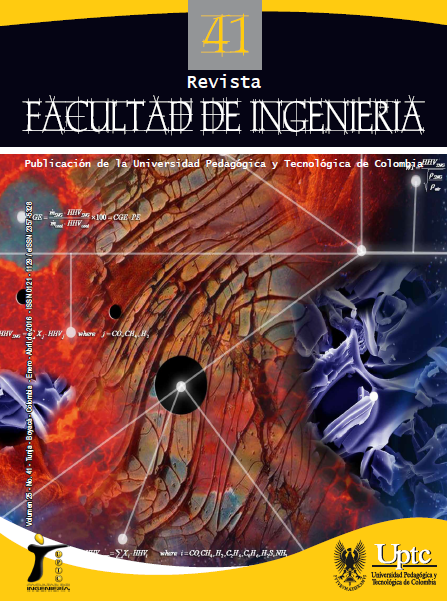Caracterización de recubrimientos DLC/Si bajo la influencia de un fluido biológico simulado

Resumen
Uno de los materiales más usados como biomaterial es el acero 316LVM, sin embargo, presenta complicaciones al trabajarlo como reemplazo permanente, debido a que libera iones metálicos a los tejidos, generando aumento en el número de intervenciones que deben realizarse, ante esto, se estudia cómo mejorar el comportamiento de materiales convencionales mediante recubrimientos que elevan sus propiedades mecánicas y anticorrosivas, incrementando su vida útil. Se evaluó el comportamiento ante el fenómeno de micro-abrasión-corrosión de recubrimientos DLC/Si depositados mediante la técnica de deposición química de vapor asistida por plasma en contacto con solución de Ringer, simulando un ambiente biológico. Los resultados indican que el recubrimiento experimenta un aumento en el volumen de desgaste cuando se encuentra sometido al mecanismo de micro-abrasión-corrosión en relación con la prueba de solo microabrasión, además, la pérdida más significativa se encuentra en el sustrato sin recubrimiento, esto demuestra el efecto protector del recubrimiento.
Palabras clave
Recubrimientos, Microabrasión, Fluido biológico
Citas
- E. H. Mirza, S. F. Akbar y M. Asif, Evaluation of Anti-Corrosion Properties of DLC Coatings for Medical Devices. Kuala Lumpur, Malaysia: University of Malaya, Biomedical Engineering (ICoBE), 2012, International Conference. DOI: https://doi.org/10.1109/ICoBE.2012.6178967
- J. Sui, W. Cai, A. Liu, Z. Wang y L. Zhao, “Surface Characterization and Blood Compatibility of Diamond-Like Carbon (DLC) Films on the NiTi Alloys”, Materials Transactions, vol. 47, no. 3, pp. 691-693, 2006. DOI: http://dx.doi.org/10.2320/matertrans.47.691. DOI: https://doi.org/10.2320/matertrans.47.691
- Y. Fu, H. Du y Q. Sun, “Interfacial structure, residual stress and adhesion of diamond coatings deposited on titanium”, Thin Solid Films, vol. 424, pp. 107-114, 2003. DOI: http://dx.doi.org/10.1016/S0040-6090(02)00908-2. DOI: https://doi.org/10.1016/S0040-6090(02)00908-2
- J. Vetter, “60 years of DLC coatings: Historical highlights and technical review of cathodic arc processes to synthesize various DLC types, and their evolution for industrial applications”, Surface and Coatings Technology, vol. 257, pp. 213-240, 2014. DOI: http://dx.doi.org/10.1016/j.surfcoat.2014.08.017. DOI: https://doi.org/10.1016/j.surfcoat.2014.08.017
- D. Luo, V. Fridrici y P. Kapsa, “Relationships between the fretting wear behavior and the ball cratering resistance of solid lubricant coatings”, Surface and Coatings Technology, vol. 204, no. 8, pp. 1259-1269, 2010. DOI: http://dx.doi.org/10.1016/j.surfcoat.2009.10.019. DOI: https://doi.org/10.1016/j.surfcoat.2009.10.019
- K. Shiba, Y. Ohgoe, K. Hirakuri1, J. Mizuno, S. Shoji, K. Ozeki y K. Sato, Hemocompatibility of DLC coating for blood analysis devices, Tokyo, Japan: School of Engineering and Graduate School of Engineering, Tokyo Denki University, Electronics Packaging (ICEP), 2014 International Conference. DOI: https://doi.org/10.1109/ICEP.2014.6826781
- A. Gant, M. Gee y A. May, “Microabrasion of WC–Co hardmetals in corrosive media”, Wear, vol. 256, no. 9-10, pp. 954-962, 2004. DOI: http://dx.doi.org/10.1016/j.wear.2003.09.003. DOI: https://doi.org/10.1016/j.wear.2003.09.003
- L. Yang, A. Neville, A. Brown, P. Ransom y A. Morina, “Friction reduction mechanisms in boundary lubricated W-doped DLC coatings”, Tribology International, vol. 70, pp. 26- 33, 2014. DOI: http://dx.doi.org/10.1016/j.triboint.2013.09.020. DOI: https://doi.org/10.1016/j.triboint.2013.09.020
- L. Bonetti, G. Capote, L. Santos y E. Corat, “Adhesion studies of diamond – like carbon films deposited on Ti6Al4V substrate with a silicon interlayer”, Thin Solid Films, vol. 515, no. 1, pp. 375-379, 2006. DOI: http://dx.doi.org/10.1016/j.tsf.2005.12.154. DOI: https://doi.org/10.1016/j.tsf.2005.12.154
- W. Aperador, G. Roa-Rodríguez y A. Mejía, “Characterization and Corrosion Behavior of Multilayer [TiAlN]nGrowthon AISI 316LVM Steel”, Int. J. Electrochem. Sci., vol. 9, pp. 5025-5034, 2014. DOI: https://doi.org/10.4028/www.scientific.net/AMM.598.13
- K. Lukaszkowicz, J. Sondor y K. Balin, “Characteristics of CrAlSiN + DLC coating deposited by lateral rotating cathode arc PVD and PACVD process”, Applied Surface Science, vol. 312, pp. 126-133, 2014. DOI: http://dx.doi.org/10.1016/j.apsusc.2014.03.024. DOI: https://doi.org/10.1016/j.apsusc.2014.03.024
- C. Martins, J. Moreira y J. Martins, “Corrosion in water supply pipe stainless steel 304 and a supply line of helium in stainless steel 316”, Engineering Failure Analysis, vol. 39, pp. 65-71, 2014. DOI: http://dx.doi.org/10.1016/j.engfailanal.2014.01.017. DOI: https://doi.org/10.1016/j.engfailanal.2014.01.017
- W. Aperador, G. Rodríguez y F. Franco, “Comportamiento de la corrosión de aleaciones de magnesio AZ31-B en ambiente marino, modificadas por el proceso de fricciónagitación”, Rev. chil. ing., vol. 20, no. 1, pp. 119-125, 2012. DOI: https://doi.org/10.4067/S0718-33052012000100012
- V. Muthukumaran y V. Selladurai, “Experimental Evaluaton of Corrosion and Hardness on AISI 316L Stainless Steel Implanted with Nitrogen and Argon Ions”, Acta Mechanica Slovaca, vol. 14, no. 1, pp. 80-87, 2010. DOI: http://dx.doi.org/10.2478/v10147-011-0011-2. DOI: https://doi.org/10.2478/v10147-011-0011-2
- D. Sun, J. Wharton, R.J.K. Wood, L. Ma y W.M. Rainforth, “Microabrasion-corrosion of cast CoCrMo alloy in simulated body fluids”, vol. 42, no. 1, pp. 99-110, 2009. DOI: https://doi.org/10.1016/j.triboint.2008.05.005
- C. Chandrasatheesh, J. Jayapriya, R. George y U. K. Mudali, “Detection and analysis of microbiologically influenced corrosion of 316L stainless steel with electrochemical noise technique”, Engineering Failure Analysis, vol. 42, pp. 133-142, 2014. DOI: http://dx.doi.org/10.1016/j.engfailanal.2014.04.002. DOI: https://doi.org/10.1016/j.engfailanal.2014.04.002
- G. Zambrano, H. Riascos y P. Prieto, “Multicapas de metal-cerámico-carbono tipo diamante (DLC): un camino para la obtención de recubrimientos superduros”, Rev. Acad. Colomb. Cienc., vol. 27, no. 103, pp. 225-231, 2003.
- Y. Liua, D. Biana, Y. Wub, N. Li, K. Qiuc y Y. Zhenga, “Influence of biocompatible metal ions (Ag, Fe, Y) on the surface chemistry, corrosion behavior and cytocompatibility of Mg–1Ca alloy treated with MEVVA”, Colloids Surf B: Biointerfaces, pp. 99-107, 2015. DOI: http://dx.doi.org/10.1016/j.colsurfb.2015.05.050. DOI: https://doi.org/10.1016/j.colsurfb.2015.05.050